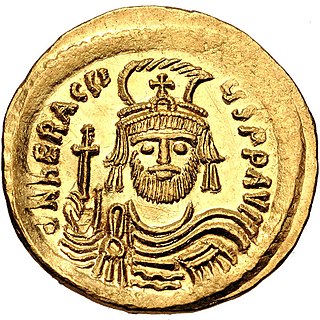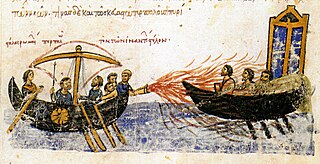Related Research Articles

Heraclius was Eastern Roman emperor from 610 to 641. His rise to power began in 608, when he and his father, Heraclius the Elder, the exarch of Africa, led a revolt against the unpopular usurper Phocas.

Tiberius III, born Apsimar, was Byzantine emperor from 698 to 705. Little is known about his early life, other than that he was a droungarios, a mid-level commander, who served in the Cibyrrhaeot Theme. In 696, Tiberius was part of an army sent by Byzantine Emperor Leontius to retake the North African city of Carthage, which had been captured by the Arab Umayyads. After seizing the city, this army was pushed back by Umayyad reinforcements and retreated to the island of Crete; some of the officers, fearing the wrath of Leontius, killed their commander, and declared Tiberius emperor. Tiberius swiftly gathered a fleet, sailed for Constantinople, and deposed Leontius. Tiberius did not attempt to retake Byzantine Africa from the Umayyads, but campaigned against them along the eastern border with some success. In 705 former emperor Justinian II, who had been deposed by Leontius, led an army of Slavs and Bulgars from the First Bulgarian Empire to Constantinople, and after entering the city secretly, deposed Tiberius. Tiberius fled to Bithynia, but was captured a few months later and beheaded by Justinian between August 705 and February 706. His body was initially thrown into the sea, but was later recovered and buried in a church on the island of Prote.

The Battle of the Yarmuk was a major battle between the army of the Byzantine Empire and the Muslim forces of the Rashidun Caliphate. The battle consisted of a series of engagements that lasted for six days in August 636, near the Yarmouk River, along what are now the borders of Syria–Jordan and Syria-Israel, southeast of the Sea of Galilee. The result of the battle was a complete Muslim victory that ended Byzantine rule in Syria. The Battle of the Yarmuk is regarded as one of the most decisive battles in military history, and it marked the first great wave of early Muslim conquests after the death of the Islamic prophet Muhammad, heralding the rapid advance of Islam into the then-Christian Levant.

The Exarchate of Africa was a division of the Byzantine Empire around Carthage that encompassed its possessions on the Western Mediterranean. Ruled by an exarch (viceroy), it was established by the Emperor Maurice in the late 580s and survived until the Muslim conquest of the Maghreb in the late 7th century. It was, along with the Exarchate of Ravenna, one of two exarchates established following the western reconquests under Emperor Justinian I to administer the territories more effectively.

The Arab–Byzantine wars were a series of wars between a number of Muslim-Arab dynasties and the Byzantine Empire from the 7th to the 11th century. Conflict started during the initial Muslim conquests, under the expansionist Rashidun and Umayyad caliphs, in the 7th century and continued by their successors until the mid-11th century.

The Battle of Ajnadayn was fought in July or August 634, in a location close to Beit Guvrin in present-day Israel; it was the first major pitched battle between the Byzantine (Roman) Empire and the army of the Arab Rashidun Caliphate. The result of the battle was a decisive Muslim victory. The details of this battle are mostly known through Muslim sources, such as the ninth-century historian al-Waqidi.

The Battle of Mu'tah took place in September 629, between the forces of Muhammad and the army of the Byzantine Empire and their Ghassanid vassals. It took place in the village of Mu'tah in Palaestina Salutaris at the east of the Jordan River and modern-day Karak.

Byzantine Armenia, sometimes known as Western Armenia, is the name given to the parts of Kingdom of Armenia that became part of the Byzantine Empire. The size of the territory varied over time, depending on the degree of control the Byzantines had over Armenia.

The first Arab siege of Constantinople in 674–678 was a major conflict of the Arab–Byzantine wars, and the first culmination of the Umayyad Caliphate's expansionist strategy towards the Byzantine Empire, led by Caliph Mu'awiya I. Mu'awiya, who had emerged in 661 as the ruler of the Muslim Arab empire following a civil war, renewed aggressive warfare against Byzantium after a lapse of some years and hoped to deliver a lethal blow by capturing the Byzantine capital, Constantinople.

The Battle of Firaz took place in late 633 or January 634 AD between the Rashidun Caliphate and the combined forces of the Byzantine Empire and the Sasanian Empire. The battle resulted in a victory for the Arabs and concluded the First Arab Invasion of Mesopotamia.
Jabala ibn al-Ayham was the last ruler, or phylarch, of the Ghassanid dynasty in Syria in the 7th century. He commanded Arab Christian tribal contingents on behalf of the Byzantine Empire against Arab Muslim forces during the Muslim conquest of Syria in the 630s. In the battles of Dumat al-Jandal in northern Arabia and the decisive battle of Yarmuk in southern Syria in 636, his forces were defeated. He supposedly converted to Islam, before breaking ties with the faith in protest to indignities he consequently suffered related to Islamic egalitarian principles. Afterward, he left Syria permanently, taking refuge with his tribesmen in Byzantine Anatolia. Historians are divided on the historicity of Jabala due the lack of contemporary source material, with some arguing his personality was essentially a literary device of later Islamic writers.

The Battle of Antioch took place in 613 outside Antioch, Turkey between a Byzantine army led by Emperor Heraclius and a Persian Sassanid army under Generals (spahbed) Shahin and Shahrbaraz as part of the Byzantine–Sassanid War of 602–628. The victorious Persians were able to maintain a hold on the recently taken Byzantine territory. The victory paved the way for a further Sasanian advance into the Levant and Anatolia.
Nicetas or Niketas was the cousin of Emperor Heraclius. He played a major role in the revolt against Phocas that brought Heraclius to the throne, where he captured Egypt for his cousin. Nicetas remained governor of Egypt thereafter, and participated also in the Byzantine–Sassanid War of 602–628, but failed to stop the Sassanid conquest of Egypt ca. 618/619. He disappears from the sources thereafter, but possibly served as Exarch of Africa until his death.
Saborios or Saborius was a Byzantine general who rose in revolt against Emperor Constans II in 667–668. He sought and obtained the aid of the Caliph Muawiyah I, but was killed in a horse accident before confronting the imperial troops.
Theodore was the brother of the Byzantine emperor Heraclius, a curopalates and leading general in Heraclius' wars against the Persians and against the Muslim conquest of the Levant.
Al-ʿAwāṣim was the Arabic term used to refer to the Muslim side of the frontier zone between the Byzantine Empire and the Umayyad and Abbasid Caliphates in Cilicia, northern Syria and Upper Mesopotamia. It was established in the early 8th century, once the first wave of the Muslim conquests ebbed, and lasted until the mid-10th century, when it was overrun by the Byzantine advance. It comprised the forward marches, comprising a chain of fortified strongholds, known as al-thughūr, and the rear or inner regions of the frontier zone, which was known as al-ʿawāṣim proper. On the Byzantine side, the Muslim marches were mirrored by the institution of the kleisourai districts and the akritai border guards.
Julian, Count of Ceuta (Spanish: Don Julián, Conde de Ceuta,, Arabic: يليان, was, according to some sources, a renegade governor, possibly a former comes in Byzantine service in Ceuta and Tangiers who subsequently submitted to the king of Visigothic Spain before secretly allying with the Muslims. According to Arab chroniclers, Julian had an important role in the Umayyad conquest of Hispania, a key event in the history of Islam, and in the subsequent history of what were to become Spain and Portugal.

The Byzantine age in Sardinian history conventionally begins with the island's reconquest by Justinian I in 534. This ended the Vandal dominion of the island after about 80 years. There was still a substantial continuity with the Roman phase at this time. The invasion of Italy by the Longobards in 568, which changed the face of Italy, only resulted in a few coastal raids on Sardinia.
Hellenization in the Byzantine Empire describes the spread and intensification of ancient Greek culture, religion and language in the Byzantine Empire. The theory of Hellenization generally applies to the influence of foreign cultures subject to Greek influence or occupation, which includes the ethnic and cultural homogenisation which took place throughout the life of the Byzantine Empire (330-1453).

David was one of three co-emperors of Byzantium for a few months in late 641, and had the regnal name Tiberius. David was the son of Emperor Heraclius and his wife and niece Empress Martina. He was born after the emperor and empress had visited Jerusalem and his given name reflects a deliberate attempt to link the imperial family with the Biblical David. The David Plates, which depict the life of King David, may likewise have been created for the young prince or to commemorate his birth. David was given the senior court title caesar in 638, in a ceremony during which he received the kamelaukion cap previously worn by his older brother Heraclonas.
References
- ↑ "Walter Kaegi, Byzantine historian named a Kentucky colonel, is dead at 84". Hyde Park Herald .
- ↑ "Walter Kaegi, noted scholar of Byzantine and Roman Empires, 1937-2022 | University of Chicago News".
- ↑ Kaegi, Walter (2010). Muslim Expansion and Byzantine Collapse in North Africa. Cambridge: University of Cambridge. ISBN 9780521196772.
- ↑ Li, Hansong; Goodyear, Michael; Otradovec, Kevin (2016). "Maturation of a Historian: Conversation with Walter Kaegi". Chicago Journal of History (6): 5.